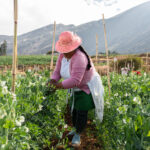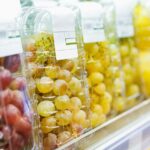Agronometrics in Charts: Red, white & blueberry - A look at the U.S. blueberry season

In this installment of the ‘Agronometrics In Charts’ series, Sarah Ilyas studies the state of the U.S. blueberry season . Each week the series looks at a different horticultural commodity, focusing on a specific origin or topic visualizing the market factors that are driving change.
The month of July holds the distinction of being recognized as National Blueberry Month. The month has long been a time of celebration for the mighty blue fruit. In addition to being an indispensable ingredient in Fourth of July recipes, such as cakes, pies, trifles, and various other desserts, blueberries play a vital role in enhancing the distinct flavors and overall culinary experience associated with this patriotic occasion.
For decades, the NABC worked with the U.S. Department of Agriculture (USDA) to achieve a proclamation for July to be known as National Blueberry Month, and in 2003, that hard work paid off when USDA first declared it as such.
Below, we take a look at how the blueberry season is currently faring across the US.
New Jersey
New Jersey is experiencing peak volume since mid-June, and crops will transition to Michigan and the Pacific Northwest at the beginning of July.
Gary Pavlis, an agricultural and natural resources county agent representing Rutgers Cooperative Extension Atlantic County, reports that the ongoing harvest exhibits promising progress. Projections indicate that more than 42 million pounds of blueberries will be picked this season in the Garden State. Pavlis lauds the abundance of labor and the steady pricing of blueberries in the market.
 Source: USDA Market News via Agronometrics.
Source: USDA Market News via Agronometrics.
(Agronometrics users can view this chart with live updates here)
Despite the prevailing aridity, the weather conditions have effectively mitigated the risk of potential diseases and crop deterioration across the majority of farms. However, Pavlis warns that the costs associated with irrigation will witness significant hikes, as growers diligently endeavor to perfect this year's crop.
“The quality is very good. The crop is average to good. We’re doing OK,” says Paul Galleta, a second-generation cultivator at Atlantic Blueberry Co. in Hammonton, once renowned as the largest blueberry farm in the world.
 Source: USDA Market News via Agronometrics.
Source: USDA Market News via Agronometrics.
(Agronometrics users can view this chart with live updates here)
Michigan
Michigan will see peak volumes in late July through mid-August. “We expect a fantastic Michigan blueberry season with exceptional varieties to delight retailers and consumers,” says Brian Bocock, vice president of product management for Naturipe Farms.
“We really love growing Naturipe blueberries in Michigan because of Lake Michigan’s temperature moderating effect and the amazing sandy loam soils. These factors create a great environment to grow blueberries near the shores of Lake Michigan,” he added.
The Michigan blueberry season will extend until mid-September, according to Bocock.
“We can’t wait for retailers and customers to taste the new varieties that are being grown in Michigan,” he said. “We have some public varieties and a few very exciting proprietary varieties that really take the best characteristics of the standard varieties and make them even better. They are firmer, more flavorful and taste even better at each bite. For retailers, they also have a better shelf life than previous varieties.”
Retailers can maximize sales of Michigan blueberries by scheduling promotions, Bocock said.
“Consumer demand for blueberries has been off the charts this year, and overall consumption has doubled in the past five-plus years, which means more consumers are looking for fresh blueberries,” he said.
 Source: USDA Market News via Agronometrics.
Source: USDA Market News via Agronometrics.
(Agronometrics users can view this chart with live updates here)
Pacific Northwest
The Pacific Northwest is poised to experience peak volumes from mid-July to early August.
Jim Roberts, President of Sales for Naturipe Farms, emphasizes the exceptional market conditions this year, driven by the tremendous demand for blueberries. The sequential transition from New Jersey to Michigan and the Pacific Northwest, coupled with favorable weather conditions, has yielded strong crops with ample volumes and enhanced quality. Roberts envisions this as an opportune moment for retailers to increase promotional activities, diversify packaging options, and achieve remarkable sales records in the blueberry category.
“Mother Nature has been kind to us this year, unlike the last three years. We are pleased to have strong crops with promotable volumes and better quality. This will provide retailers with the opportunity to increase promotional frequency, open up displays with multiple pack sizes, and achieve record sales in the category.”
Related articles: Largest British blueberry crop ever expected for 2023
California Giant Berry Farms anticipates a fruitful summer characterized by abundant blueberry yields. The company's commitment to high-quality produce aligns seamlessly with the unwavering consumer demand for blueberries.
“We’re forecasting a strong harvest of conventional blueberries out of Oregon and British Columbia and organic harvest out of Oregon and Washington in July and August. We’re on the right track to have a very positive year of high-quality blueberries,” says Alan Ediger, vice president of sales at California Giant Berry Farms.
The blueberry growers affiliated with California Giant in Oregon are diligently preparing for their initial harvest, slated to commence in the first week of July. This will be followed by a wide supply window, extending from mid-July to mid-August, encompassing both conventional and organic fruit, allowing for substantial promotional opportunities.
Washington's growing regions, although offering a lighter supply, will provide a steady stream of organic volumes from early July through the conclusion of August, supplementing California Giant's organic blueberry program.
 Source: USDA Market News via Agronometrics.
Source: USDA Market News via Agronometrics.
(Agronometrics users can view this chart with live updates here)
In our ‘In Charts’ series, we work to tell some of the stories that are moving the industry. Feel free to take a look at the other articles by clicking here.
All pricing for domestic US produce represents the spot market at Shipping Point (i.e. packing house/climate controlled warehouse, etc.). For imported fruit, the pricing data represents the spot market at Port of Entry.
You can keep track of the markets daily through Agronometrics, a data visualization tool built to help the industry make sense of the huge amounts of data that professionals need to access to make informed decisions. If you found the information and the charts from this article useful, feel free to visit us at www.agronometrics.com where you can easily access these same graphs, or explore the other 21 commodities we currently track.














































